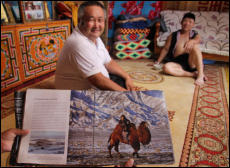

© Nova Fisher novatravels.net

The Gobi
You might imagine the Gobi desert as a classic desert with sand- dunes. I did. But it’s not. Yes, it has 200m sand-dunes in a tiny corner and some rocky out - crops, but the main desert is mile after (hundreds of) miles of entirely empty, barren, flat gravel plains, without much grass. Driving across the desert involves following dirt tracks. No signs, no proper roads. Drivers navigate by the mountains on the horizon, and while they usually follow the, sometimes very vague, dirt tracks they think noth - ing of just turning off and driving off road, often at 70 mph heading for some invisible landmark in the distance.
Nomadic Camel herders
In the inhospitable landscapes of the Gobi there is a scattering of nomadic camel herders. We visited a nomadic family, headed by Ganbold. He and his family’s survival depends on their 1000 animals – cashmere goats for income, sheep for food and 50 Bactrian camels for riding, wool and milk. In the winter they move their ger and livestock to more sheltered land in the Khongoryn Els dunes. A constant threat to their animals are the grey wolves. Ganbold and our driver did the traditional nomadic greeting of taking each other’s snuff. After drinking camels milk tea, we then went on a ride to the sand dunes on his camels. Ganbold, has been featured in a BBC programme and book on Human Nature.
Khongoryn Els (Khongor dunes)
We drove west from Dalanzadgad, past our ger camp to the sand dunes of Khongoryn Els known as the Singing Dunes, but unfortunately, arrived too late to see the sunset and views from the top. The Khongor dunes are some of the largest and most spectacular sand dunes in Mongolia. Rising as high as 200 meters, the dunes are 7-8kms wide and about 100 kms long. The dunes rise up between a spur of the Gobi-Altai Mountains to the south, and springs and oases on the north lush green side. Known as “Singing Sands,” because they sing while you climb - they say that the eerie music can be heard when the wind blows, or when you walk or slide on the sand. (I didn’t hear it even though it was windy!)

Khavtsgait Petroglyphs
We headed back east, stopping at Khavtsgait to walk up the rocky outcrop and explore the petroglyphs (ancient engravings). From the top there’s a fantastic view over the surrounding plains. Looking down we saw an old Russian army village of about a dozen houses and closeby is the woodland that the Russians had planted but all of this is derelict now. Khavtsgait petroglyphs are a collection of ancient engravings. Some of this rock art is thought to date back as early as 3000BC. The engravings that depict wild animals were probably drawn by hunters whilst waiting for their prey.
Gobi Desert
Unlike
any
other
desert
I
know,
it
gets
snow
in
winter
-
a
lot
of
it.
We
were
told
that
last
year
there
was
1m
of
snow
covering
the
desert.
Gobi is a land of extremes with temperatures of +40°c in summer
and
as
low
as
-40°c
in
winter,
strong
winds
in
spring
and
autumn
and
sudden
sand
and
snowstorms.
You
wonder
how
on
earth
or,
perhaps, why on earth people live in this environment.
The
Gobi
Desert
covers
much
of
southern
Mongolia,
and
about
40%
of
the
country
as
a
whole.
It
is
the
habitat
of
the
Bactrian
Camels,
Argali
mountain
sheep,
Golden
eagles,
Saker
falcons,
lam-¬mergey
-
ers,
Altai
snow
cocks,
ibex,
yaks
and
Jerboas
that
resemble
the
Kangaroo rats.



Bulgan village
We called into the small village of Bulgan and whilst our punctured tyre was being repaired we visited one of Gobi's few organic farms and the village shops. We had to wait for the petrol lady to return from lunch so that we could fill up with petrol. We stopped shortly after for a picnic lunch, near a flock of sheep and goats, during which we were invaded by bees..

Yolm Am
We wandered down the lush valley of Yolm Am into the gorge with steep rock faces,(200m in places) criss-crossing the stream as we went. As the gorge narrowed we started to walk on deep ice. The return trek took us 90 minutes. Yolyn Am is a deep and narrow gorge in the Gurvan Saikhan Mountains. The name translates as Lammergeier Valley. The Lammergeier is an Old World vulture, hence the name is often translated to Valley of the Vultures or Valley of the Eagles. Although the area sees little precipitation, Yolyn Am is notable for a deep ice field. The ice field reaches several metres thick by the end of winter, and is several kilometres long. In past years it remained year round, but these days the ice field tends to disappear by late August.

Bayanzag
We walked around the spectacular sandstone formations, glowing orange at sunset. Bay - anzag known as the Flaming Cliffs due to its deeply red coloured sandy rock that glows orange at sunset, is one of the most famous palaeontological sites in the world. Huge shelves of rock and sand descend into many canyons that meander down to the desert floor. In 1922, Roy Chapman Andrews discovered the world's first nest of dinosaur eggs here and unearthed over 100 dinosaurs. Other finds in the area include specimens of Velo - ciraptor and eutherian mammals. It is known as the ‘Dinosaur Cemetery’.




























